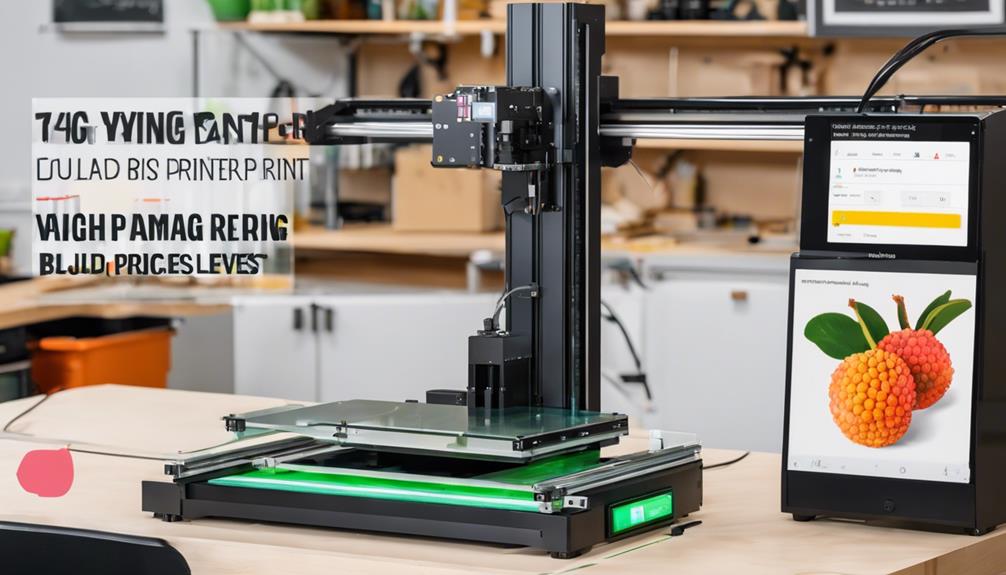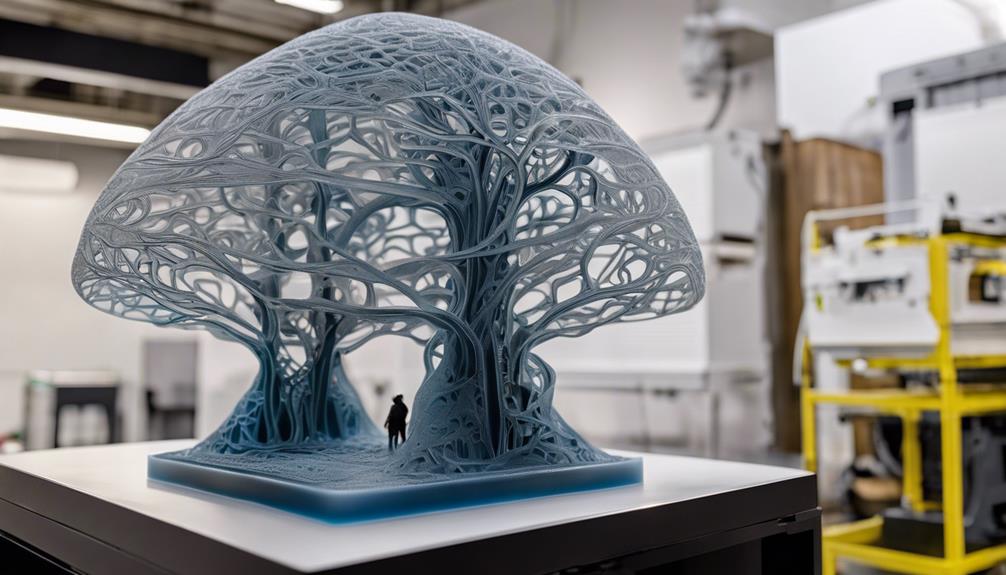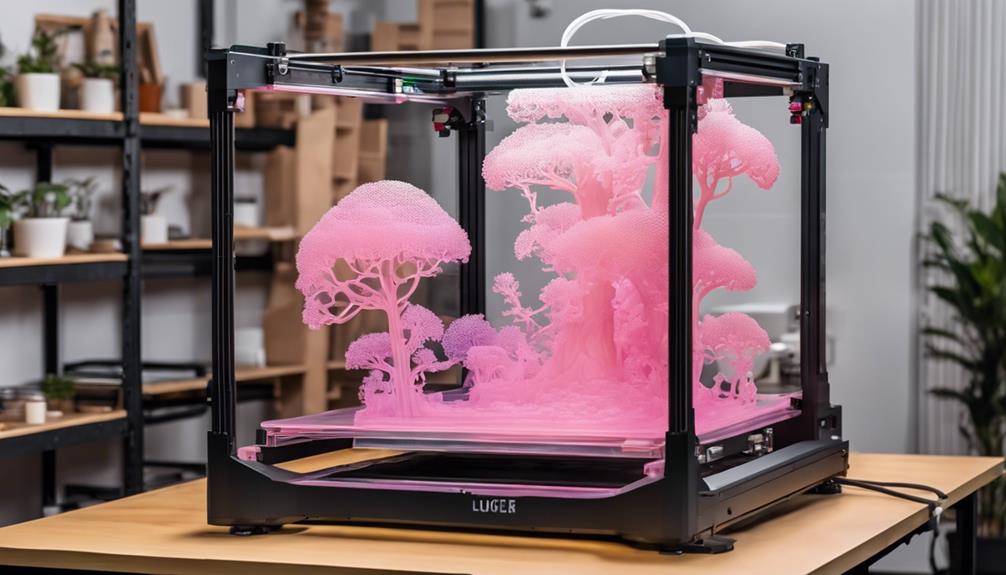When facing the challenge of resin printing sizable objects on your Lychee printer, mastering the intricacies of calibration and resin selection is just the beginning. From optimizing print settings to understanding the nuances of support structures, each step plays a vital role in achieving flawless results. However, there's a pivotal aspect that often goes overlooked, a secret ingredient that can elevate your prints from good to exceptional. Stay tuned as we reveal this key factor that can make all the difference in your quest for perfect large resin prints on Lychee.
Key Takeaways
- Ensure proper bed calibration for large prints.
- Use strong supports strategically.
- Optimize print orientation for stability.
- Consider resin viscosity for intricate details.
- Allow sufficient curing time for big prints.
Printer Setup

For a efficient printing process, calibrate your Lychee resin printer following the manufacturer's guidelines. Proper calibration guarantees that your prints will be precise and accurate.
Start by checking the build plate leveling. Make sure it's parallel to the LCD screen to prevent any issues during printing.
Next, examine the resin tank for any damage or cloudiness. A clean and clear resin tank is essential for successful prints.
After checking the build plate and resin tank, it's time to load the resin. Use a high-quality resin recommended by the manufacturer to achieve the best results. Ensure that the resin is at the right temperature for ideal printing conditions. Additionally, remember to wear gloves and work in a well-ventilated area when handling resin.
Lastly, review the printer's settings and make any necessary adjustments for the specific model you're using. Double-check the exposure times, layer heights, and curing settings to match the requirements of your print job.
With a properly calibrated printer, you're now ready to move on to bed calibration for flawless resin printing on your Lychee printer.
Bed Calibration
How can you guarantee precise and accurate resin printing on your Lychee printer through proper bed calibration?
Bed calibration is essential for ensuring that the first layer of your print adheres correctly to the build plate, leading to successful prints.
To start, make sure your printer is on a stable surface and the build plate is clean. Begin the calibration process by adjusting the build plate height using the printer's settings or manual adjustment screws until it's at the ideal distance from the LCD screen. This distance is usually around 0.1mm to 0.2mm, but it can vary based on your specific printer model.
Next, perform a test print to check the first layer's adhesion. If the resin spreads too much or doesn't stick well, readjust the build plate height accordingly. Repeat this process until you achieve a smooth, level first layer.
Proper bed calibration is necessary for successful resin printing and can save you time and resin by preventing failed prints.
Resin Selection

To guarantee successful resin printing on your Lychee printer, carefully contemplate the type of resin you select for your project. Choosing the right resin is vital as it directly affects the quality and durability of your prints. When selecting a resin, factors to ponder include the color, transparency, flexibility, and curing time it offers.
Opt for resins that are specifically recommended for your Lychee printer model to ensure compatibility and best results. Different resins have varying properties, such as standard resins for general use, tough resins for more durable prints, or flexible resins for parts requiring some degree of flexibility.
Additionally, take into consideration the curing wavelength required for the resin as some resins are designed for specific wavelengths emitted by different printers. It's crucial to follow the manufacturer's guidelines on resin compatibility and settings to prevent issues during the printing process.
Slicing Software Configuration
Consider configuring your slicing software settings to optimize the printing process on your Lychee resin printer. Proper configuration plays an essential role in achieving high-quality prints and efficient use of resin.
Start by adjusting the layer height, typically ranging from 0.05mm to 0.1mm, to balance print speed and detail. Experiment with different exposure times for the bottom layers and regular layers to guarantee proper curing without overexposure. Fine-tune the light-off delay, lift speed, and retract speed to prevent failed prints and ensure successful layer adhesion.
Additionally, enable features like anti-aliasing to smooth out jagged edges and improve overall print quality. Consider adding supports strategically to provide stability during the printing process while minimizing the need for excessive post-processing.
Make sure that your slicing software is compatible with Lychee resin printers to avoid compatibility issues. By customizing these settings based on your specific project requirements, you can enhance the overall printing experience and achieve impressive results with your Lychee resin printer.
Print Orientation

Optimizing the print orientation of your models is essential to maximizing the quality and success of your prints on a Lychee resin printer. When deciding how to position your model for printing, consider factors like overhangs, details, and structural integrity.
To achieve the best results, aim to minimize the number of overhangs in your print. Orienting your model in a way that reduces the need for extensive supports can improve the overall surface finish and reduce the risk of failed prints.
Additionally, positioning intricate details or fine features facing upwards can help preserve their sharpness and accuracy during the printing process.
It's also important to think about the structural strength of your print. If your model has specific load-bearing parts or fragile sections, orienting them strategically can enhance their durability and reduce the likelihood of breakage.
Experiment with different orientations in your slicing software to find the ideal position that balances print quality, support requirements, and structural integrity for your specific model.
Support Structures
Minimize the need for extensive supports by strategically positioning your model to enhance print quality and structural integrity when utilizing support structures on a Lychee resin printer. By orienting your model appropriately, you can reduce the reliance on supports, saving resin and post-processing time.
When adding supports, make sure they're only placed where necessary, such as underhangs or areas with steep overhang angles. Consider the overhang angle at which supports are required; generally, the steeper the overhang, the more support needed. However, try to design your model with self-supporting angles wherever possible to decrease the need for excessive supports.
Another tip is to utilize tree-like support structures that branch out to provide stability without overwhelming the print with unnecessary supports. These structures are customizable and can be adjusted to suit the specific requirements of your model.
Remember to inspect and optimize your support structures using slicing software to confirm they adequately support your design while maintaining the desired surface finish. Properly positioned and optimized support structures will contribute significantly to the successful printing of large pieces on your Lychee resin printer.
Printing Process

When printing on your Lychee resin printer, make sure to calibrate the machine settings accurately to achieve the best results for your large resin pieces. Proper calibration guarantees that the layers adhere correctly, resulting in a high-quality final print. Here are some key points to keep in mind during the printing process:
| Printing Process Tips | Description |
|---|---|
| Layer Height | Set the layer height according to your desired level of detail. Smaller layers provide higher resolution prints. |
| Exposure Time | Adjust the exposure time based on the resin you are using. Longer exposure times can improve layer adhesion. |
| Printing Speed | Control the printing speed to balance detail and efficiency. Slower speeds can enhance accuracy but take longer. |
Post-Processing
For effective post-processing of your resin prints on Lychee, attention to detail in removing supports and curing is key to achieving a professional finish. After printing your large piece, follow these steps for the best post-processing:
- Support Removal: Carefully remove the supports using flush cutters or pliers, making sure not to damage the main print. Take your time to clean up any remaining nubs or rough areas for a clean look.
- Washing: Thoroughly wash your print in isopropyl alcohol to remove any uncured resin. Use a soft brush to gently scrub the print, especially in intricate areas, to ensure all residues are removed.
- Curing: Place your print under a UV light or in a curing chamber to fully cure the resin. Make sure all parts of the print are exposed to the light for even curing.
- Final Touches: Sand the print lightly to smoothen any imperfections, and apply a finishing coat if desired for a polished look. Your print is now ready for display or further customization.
Conclusion
To sum up, by following these steps to resin print large pieces on a Lychee printer, you can achieve impressive results with minimal hassle.
Remember to carefully calibrate your printer, choose the right resin, optimize your slicing settings, and pay attention to print orientation and support structures.
With proper post-processing, your prints will be showcase-worthy.
Happy printing!